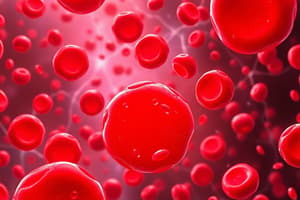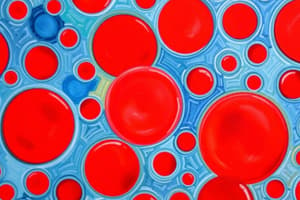Podcast
Questions and Answers
What is the main function of red blood cells in the body?
What is the main function of red blood cells in the body?
- Stabilizing body temperature
- Transporting oxygen and carbon dioxide (correct)
- Defending against toxins and pathogens
- Transporting metabolic wastes
Which component of blood takes up the largest volume percentage?
Which component of blood takes up the largest volume percentage?
- Red blood cells
- Water (correct)
- White blood cells
- Plasma proteins
What is the purpose of platelets in the blood?
What is the purpose of platelets in the blood?
- Defending against pathogens
- Maintaining pH levels
- Protection from blood loss (correct)
- Transporting oxygen
What is meant by 'fractionation' of whole blood?
What is meant by 'fractionation' of whole blood?
Which blood component is responsible for the body’s defense against toxins?
Which blood component is responsible for the body’s defense against toxins?
What percentage of whole blood is made up of formed elements?
What percentage of whole blood is made up of formed elements?
Which component of blood is primarily responsible for maintaining body temperature?
Which component of blood is primarily responsible for maintaining body temperature?
Fractionation of whole blood primarily relies on what process?
Fractionation of whole blood primarily relies on what process?
What is the largest component of plasma by volume?
What is the largest component of plasma by volume?
Which of the following is least represented in whole blood?
Which of the following is least represented in whole blood?
What role do antibodies play in the blood?
What role do antibodies play in the blood?
Which statement about the composition of blood is accurate?
Which statement about the composition of blood is accurate?
Which of the following functions is not performed by red blood cells?
Which of the following functions is not performed by red blood cells?
What does the term 'buffy coat' refer to in the context of blood?
What does the term 'buffy coat' refer to in the context of blood?
Flashcards
Blood Composition
Blood Composition
Blood is a specialized fluid connective tissue with cells in a fluid matrix.
Function of Blood: Transport
Function of Blood: Transport
Blood delivers essential materials to cells and removes wastes.
Function of Blood: Regulation
Function of Blood: Regulation
Blood maintains body temperature, pH levels, and fluid volume.
Function of Blood: Defense
Function of Blood: Defense
Signup and view all the flashcards
Function of Blood: Protection
Function of Blood: Protection
Signup and view all the flashcards
Plasma Composition
Plasma Composition
Signup and view all the flashcards
Water in Plasma
Water in Plasma
Signup and view all the flashcards
Plasma Proteins
Plasma Proteins
Signup and view all the flashcards
Other Solutes in Plasma
Other Solutes in Plasma
Signup and view all the flashcards
Formed Elements in Blood
Formed Elements in Blood
Signup and view all the flashcards
Red Blood Cells (RBC)
Red Blood Cells (RBC)
Signup and view all the flashcards
White Blood Cells (WBC)
White Blood Cells (WBC)
Signup and view all the flashcards
Platelets
Platelets
Signup and view all the flashcards
Fractionation of Blood
Fractionation of Blood
Signup and view all the flashcards
Study Notes
Overview of Blood Composition
- Blood is a specialized fluid connective tissue containing cells suspended in a fluid matrix.
- It plays a crucial role in transporting materials, including oxygen (O2), carbon dioxide (CO2), nutrients, and hormones.
Functions of Blood
- Transport: Delivers essential materials to cells and removes metabolic wastes.
- Regulation: Maintains body temperature, pH levels, and fluid volume.
- Defense: Protects against toxins and pathogens using antibodies and white blood cells (WBC).
- Protection: Aids in preventing blood and fluid loss through platelets and clotting enzymes.
Blood Composition Breakdown
-
Blood is composed of 55% plasma and 45% formed elements.
-
Plasma Composition:
- Water: 92% of plasma, the main component.
- Plasma Proteins: Constitute about 7% of plasma.
- Other Solutes: Include electrolytes, nutrients, waste products, and gases.
-
Formed Elements Breakdown:
- Red Blood Cells (RBC): Represent around 99.9% of formed elements.
- White Blood Cells (WBC) and Platelets: Each accounts for less than 0.1%.
Clinical Analysis of Blood
- Whole blood can be analyzed by separating its components through centrifugation, known as fractionation.
- The separation yields:
- Plasma: Comprises 55% of total blood volume.
- Buffy Coat: Contains white blood cells and platelets.
Overview of Blood Composition
- Blood is a specialized fluid connective tissue containing cells suspended in a fluid matrix.
- It plays a crucial role in transporting materials, including oxygen (O2), carbon dioxide (CO2), nutrients, and hormones.
Functions of Blood
- Transport: Delivers essential materials to cells and removes metabolic wastes.
- Regulation: Maintains body temperature, pH levels, and fluid volume.
- Defense: Protects against toxins and pathogens using antibodies and white blood cells (WBC).
- Protection: Aids in preventing blood and fluid loss through platelets and clotting enzymes.
Blood Composition Breakdown
-
Blood is composed of 55% plasma and 45% formed elements.
-
Plasma Composition:
- Water: 92% of plasma, the main component.
- Plasma Proteins: Constitute about 7% of plasma.
- Other Solutes: Include electrolytes, nutrients, waste products, and gases.
-
Formed Elements Breakdown:
- Red Blood Cells (RBC): Represent around 99.9% of formed elements.
- White Blood Cells (WBC) and Platelets: Each accounts for less than 0.1%.
Clinical Analysis of Blood
- Whole blood can be analyzed by separating its components through centrifugation, known as fractionation.
- The separation yields:
- Plasma: Comprises 55% of total blood volume.
- Buffy Coat: Contains white blood cells and platelets.
Studying That Suits You
Use AI to generate personalized quizzes and flashcards to suit your learning preferences.




